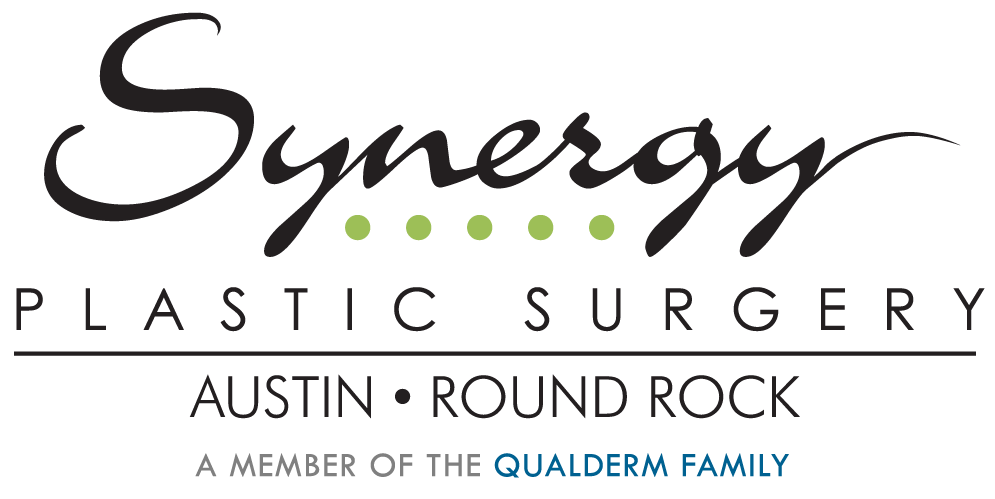For many women considering breast implants, one of the top concerns is what kind of scar the surgery might leave behind. This guide will help you understand what breast augmentation scars look like at each stage, where they’re placed, how they heal, and what you can do to support beautiful, lasting results.
Beauty In Every Detail
Real patients, real life-changing transformations. See the results that are possible in our before-and-after gallery.
View Photo GalleryWhere Are Breast Augmentation Scars Typically Located?
Our board-certified plastic surgeons will work closely with you to choose the incision location that best suits your anatomy and goals. While each technique has advantages, the most common incision types include:
- Inframammary (under the breast): This incision is placed discreetly in the crease beneath the breast, where it’s naturally concealed. It’s our most common approach at Synergy Plastic Surgery because it gives our surgeons excellent control during implant placement and minimal visibility once healed.
- Periareolar (around the nipple): This incision traces the outer edge of the areola, where the transition between darker and lighter skin helps camouflage scarring. It’s typically used for patients with smaller areolas and may not be ideal for those planning to breastfeed in the future.
- Transaxillary (through the armpit): This less commonly used incision is placed in the underarm to keep scars off the breast entirely. However, it offers less direct access and may not be suitable for all implant types or revision surgeries.
What Do the Scars Look Like Right After Surgery?
Immediately after surgery, your incision lines are fresh and still in the early healing phase. Here’s what to expect:
- Color: At first, scars often appear darker, lighter, or redder than your natural skin tone, depending on your individual skin type and how your body responds to healing. This is normal and usually fades as the scar matures.
- Texture: Early scars may feel slightly raised or firm due to new collagen production during tissue repair.
- Dressings: Compression garments and surgical tape may be applied over the incisions to protect the area, reduce swelling, and promote even healing.
It’s important to remember that scars almost always look more noticeable in the beginning. This stage is a temporary and normal part of breast augmentation recovery.
How Long Do Breast Augmentation Scars Take To Fade?
The scar maturation process is gradual, often taking several months to a year or more. Here’s a general timeline:
- First 4 to 6 weeks: Scars may look red, brown, or lighter than your natural skin tone and feel slightly raised. This is the body’s normal inflammatory response.
- 3-month mark: Most patients see scars begin to flatten and soften. Some patients also notice the scar color starting to blend more with the surrounding skin, although this can take longer for those with darker skin tones.
- 1-year point: Scars often fade to thinner, flatter lines that match your skin tone more closely. In many cases, they become less noticeable, especially in hidden locations like the inframammary fold. However, scar color may continue evolving beyond a year, particularly for individuals with more richly pigmented skin.
Keep in mind that everybody heals differently. Genetics, skin tone, scar location, and consistency with aftercare all play a role in your final outcome.
Can Anything Be Done To Minimize Scarring?
Absolutely. While scarring can’t be eliminated entirely, several strategies help minimize its appearance:
- Choose a skilled, board-certified surgeon: Technique matters. Precise incisions, minimal tension on the skin, and layered closure techniques all support better scar outcomes.
- Use scar care products: Your surgeon may recommend silicone sheets or gels, which help flatten and fade scars over time.
- Avoid sun exposure: UV rays can darken healing scars. Wear clothing that covers the area, or use broad-spectrum SPF once the incisions are closed.
- Don’t smoke: Smoking impairs circulation and collagen production, both of which are critical for optimal healing.
- Follow your aftercare instructions: Proper dressing changes, keeping the area clean, and attending follow-up visits all contribute to better healing. Discover recovery tips for a smoother healing process in our blog post.
What About Scar Revision or Laser Treatments?
Most patients find their breast augmentation scars fade beautifully on their own. However, treatments are available if you’re self-conscious about a scar long after healing. These include:
- Laser therapy to reduce redness and smooth texture
- Microneedling to stimulate collagen and break up scar tissue
- Steroid injections for raised or hypertrophic scars
- Surgical revision for more noticeable scarring, though this is rarely needed
Your surgeon can advise whether any of these options would be helpful in your case.
Breast Implants With Lift Scars
In some cases, breast augmentation alone may not achieve the desired breast shape or elevation, especially if the breasts sag significantly. That’s why some women are better candidates for a breast lift or a combined breast augmentation with lift. These procedures address sagging by removing excess tissue and repositioning the breasts higher on the chest wall, but they also involve additional incisions that result in different scar patterns.
- Breast lift scars: Depending on the degree of lift needed, incisions may include a circular pattern around the areola (doughnut or concentric), an incision around the areola and a vertical line down to the breast crease (“lollipop”), or a full anchor pattern (lollipop plus a horizontal line along the inframammary fold). While more extensive, these scars usually fade nicely over time.
- Breast lift with implants scars: Your surgeon will insert the implants through one of the breast lift incisions. The placement will depend on how much lift is needed and the size of your breast implants.
In both procedures, scar care strategies are similar to those used after augmentation, and most women feel the long-term benefits far outweigh the visibility of scars.
See Real Before-and-After Photos
Curious what your results might look like? Browse our breast augmentation before and after photos to see how real patients have healed. You’ll notice that scars are typically very discreet—and in many cases, barely visible.
Breast Augmentation FAQ
Will my breast augmentation scars be permanent?
Yes, but they usually fade significantly over time. Most become fine, faint lines that are barely noticeable.
Can I request a specific incision location?
In most cases, yes. Your surgeon will help you choose the incision that balances your aesthetic goals with surgical safety and visibility preferences.
Do silicone strips really help with scar healing?
Yes. Silicone strips or gels are clinically proven to improve scar appearance when used consistently.
How noticeable are scars in a bikini or bra?
Most incisions, especially inframammary incisions, are placed in areas hidden by bras or bikini tops. With time, they often fade into near invisibility.
Will the drop and fluff process affect what my scars look like?
Yes, but only indirectly. As your breast implants settle during the drop and fluff process, your breasts gradually take on a more natural shape and position. This can change how your scars appear in relation to your new breast contour. For example, inframammary scars (under the breast) may look higher on the breast immediately after surgery, but as the implants drop and the breast shape rounds out, these scars often become less noticeable and more hidden in the natural fold.
While both implant settling and scar maturation occur in the months after surgery, they are separate processes. Scar appearance improves over time as the tissue heals, regardless of how the implants settle.
How can I sleep after surgery to protect my incisions?
Maintaining proper sleep posture during the first few weeks can reduce tension on your healing incisions, ultimately affecting the appearance of your scars. Read our blog post on how to sleep after surgery to protect your incisions.
Considering Breast Augmentation? Let’s Talk About Your Options
Our experienced team at Synergy Plastic Surgery will work closely with you to develop a customized treatment plan that addresses your unique goals while minimizing scarring and ensuring optimal results. Request a consultation or call us at (512) 244-1439 to explore your breast enhancement options.



Leave a Reply